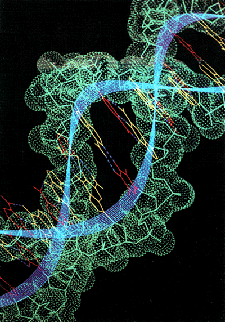Two is a key number in the living world. Not only in what is related to independent organisms, but also in the cell nucleus: in a series of studies by Weizmann Institute of Science scientists it was found that central DNA repair processes are based on the complementary action of two unique enzymes.

Prof. Zvi Livna from the Department of Biological Chemistry at the Weizmann Institute of Science, who has been researching DNA repair processes for two decades: "The DNA of every cell in our body is damaged approximately 20 times every day, as a result of radiation, pollutants and various harmful substances produced within the body itself. Given this, it is clear that without DNA repair processes life as we know it could not exist. Most types of damage lead to point mutations, a kind of "typing mistakes" in the genetic code, which are corrected by enzymes that work with a fairly good level of accuracy. But sometimes the meaning of the damage is not just a simple typographical error. In such cases, gaps may form in the DNA molecule that prevent it from replicating when the cell divides, just as an ink stain or a hole in a page in a book interferes with reading. These gaps are so dangerous that the cell eliminates them with a careless but effective method of operation: it fills in the missing DNA inaccurately. This type of repair can indeed save the cell from death, but it has a price: this error-prone mechanism, which was discovered about a decade ago at the Weizmann Institute of Science and a number of other research institutes in the world, is a main source of mutations."
In the research he recently carried out, together with research students Sigal Shahar and Omer Ziv, and in collaboration with scientists from the USA and Germany, Prof. Livna discovered how this error-prone correction method works. The scientists found that the repair is carried out in two stages and requires the complementary action of two types of enzymes, belonging to the family of polymerase enzymes, which make up the DNA. Initially, the first repair enzyme, the "inserter", does its best to insert a genetic "signal" into the gap, in front of the damaged spot in the DNA molecule. This action can be performed by several repair enzymes and sometimes leads to the insertion of an incorrect genetic signal (which means the creation of a mutation). In the second step, another enzyme, the "elongator", helps resume normal DNA replication by joining additional DNA letters after the damaged site. There is only one repair enzyme capable of performing this essential step, and it is called DNA polymerase zeta (ζ). These findings were recently published in the scientific journal EMBO Journal.

Understanding this important and essential mechanism for DNA repair can lead to the development of medical applications. Defects in the DNA repair process may increase the risk of getting cancer. Therefore, if we better understand the DNA repair processes, we may be able, in the future, to improve these processes in people whose body's repair processes are not efficient enough. In addition, it is possible that the knowledge gained in these studies could help increase the effectiveness of anti-cancer drugs. Cancer cells resist these drugs by activating their natural DNA repair mechanisms, and blocking these mechanisms may weaken their resistance and expose them to the drug's action, thus improving its effectiveness.
More on the subject on the science website
